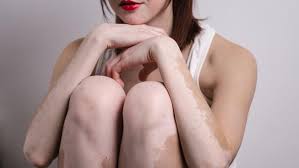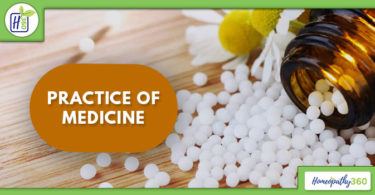 Abstract: Vitiligo ailment is regarded as complex chronic disorder and difficult to treat due to its challenging etiopathogenesis. Attempt has been made to treat a case with homoeopathic medicines. Case was registered at the OPD of NHMC, New Delhi in 2011for the complaints of white patches on face and hand. Case history, clinical diagnosis and internationally accepted VIDA and VASI tests were performed at beginning of study. After thorough analysis homoeopathic medicines were prescribed on fort nightly basis. Improvement was monitored regularly by visual examination and patient photograph was taken at every three months. Results of case showed consistent improvement of depigmented lesions. Clinical evaluation suggests that homoeopathic medicines can provide effective treatment for vitiligo disorder.
Abstract: Vitiligo ailment is regarded as complex chronic disorder and difficult to treat due to its challenging etiopathogenesis. Attempt has been made to treat a case with homoeopathic medicines. Case was registered at the OPD of NHMC, New Delhi in 2011for the complaints of white patches on face and hand. Case history, clinical diagnosis and internationally accepted VIDA and VASI tests were performed at beginning of study. After thorough analysis homoeopathic medicines were prescribed on fort nightly basis. Improvement was monitored regularly by visual examination and patient photograph was taken at every three months. Results of case showed consistent improvement of depigmented lesions. Clinical evaluation suggests that homoeopathic medicines can provide effective treatment for vitiligo disorder.
Introduction
Vitiligo is a cutaneous depigmentation chronic disorder. In India it affects at least 2-8 % of the population and occurs in all ethnic, age and sex groups (1). Vitiligo not only affects the individual but also members of family and, discord from society (2). Its etiopathogenesis is not well understood and established (3). Several causative factors have been assigned for the development of white patches on the surface of skin such as autoimmune deficiencies created by genetic and environmental factors, physical trauma, stress or illness, diet etc. (4- 11). Due to absence well understood causative factors for the genesis of disorder, currently there are not very well designed, efficient and satisfactory therapeutic methodologies are available ( have been assigned for the genesis of this disorder. Although, vitiligo is not a communicable or infectious disorder, it has a great social and psychological impact on suffering individual and society. In allopathic system corticosteroids, topical immunomodulators, photo (chemo) therapy, surgery along with combination of therapies for the control of vitiligo are prescribed (12). But it is still struggling to provide effective remedial methodology for depigmentation ailment and which are available are not fully successful. Complementary and alternative medical therapeutic system has been suggested to provide curative methodology for alleviation of vitiligo disorder condition (13-17). Several homoeopathic clinical studies are done for the treatment of vitiligo disorder, but studies were not well designed with limited aims and objectives (18-31). Present homoeopathic study has been done with full faith and dedication to provide homoeopathic remedial methodology for the cure of vitiligo disorder.
Clinical Experimental Procedure:
Name of Case: Mr. H Age/Sex: 11 yr old Male
Case History: Mr. H an 11 yr old male adolescent boy came to Out Patient Department of Nehru Homoeopathic Medical College & Hospital, New Delhi -110024 with depigmented patches on face and back. In general appearance boy was lean and thin with average weight and height. He came from the family of lower middle class having five more brothers and sister. It was found during conversation that he lives in slum area near drain site. Also, it looked food and general hygienic amenities are absent for the patient, even he can not afford good treatment. Leukodermal patches appeared in the patient 2 years back, but taken lightly. Patient attendant described that he noticed first time small white depigmented spot developed on back of Mr. H, later on it started increasing in size. Some time later depigmented patches appeared around right eye and then around left eye. There were no associated symptoms. He took allopathic treatment without any relief and the patches keep on increasing in size.
Past Family History of Case: It is noticed that his paternal aunt had vitiligo since her childhood. There was also family history of diabetes (father and paternal grandmother). Case desire for food and thirst for water were in normal limit. But he likes sweets and fried food more than normal diet. Subject had complaint of bed wetting once or twice in a week.
Mental Assessment: Looks timid doing foolish acts, Naughty and Memory was weak and very weak in studies.
Skin examination: Distribution of lesion was non-segmental, present on face and lower back.
Before starting homoeopathic regimen for case:
1. Preliminary Screening of Patient: Haematological Blood Profile: Complete Blood Examination (Hb, Hct, Total WBC Count, Platelet count and RBC indices viz. Total RBC count, MCV, MCH. and Differential Leukocytic Count etc.) Lipid Profile Blood Sugar Urine Examination: Bile pigments, Cortisol Level 2. Evaluation of Case vitiligo condition by International Dermatological Vitiligo Assessment Score System
Vitiligo scores systems are commonly used and uniformly accepted for the assessment of vitiligo disorder.
1.Vitiligo Disease Activity Score (VIDA)(32)
2.Vitiligo Area Severity Index (VASI) (33)
Before Homoeopathic Treatment (On 20/1/11) : VIDA = +4 and VASI = 1.15%
On general and systemic examination: Nothing abnormal was detected except Bed Wetting Problem
Patient Clinical Diagnostic investigations: Showed Normal range profile i.e. Blood, Stool, Urine examinations and Thyroid Function Test
Miasmatic Diagnosis: Psoro-Syphilitic state RRubrics Selected:
Mind :Timidity having Foolish Behaviours – Below normal IQ level of Children
Mind : Naughty and Mischievous personality
General Features: Appetite for Food and Drinks: Desire for Sweets and Fried food
Urinary Bladder on palpation:Normal
Urination: Uncontrolled and Involuntary at Night,
Patient Skin Dermatology: Non Segmental Vitiligo Patches on Face and Back
Reportorial Results: 1. Mercurius solubilis:12/6
2. Phosphorus: 10/6 3. Calcarea carbonica:10/5
4. Silicea terra: 10/5
5. Arsenic alb: 9/5
6. Baryta carbonica:8/5
7. 7. Nux vomica: 8/5
Prescription and Follow-Ups
On 20/1/11: Mercurius solubilis 200/1dose was given on the basis of reportorial totality also anti syphilitic miasmatic reasons
On 2/2/11: No improvement of white patches condition, Bed wetting: On going . Case was not well due to stomach upset, Given One dose of Mercurius solubilis 200, followed by Silicea 200 One dose/daily for 2 weeks.
Advised Special Food and Diet regimen during the course of study period, along with homoeopathic regimen to obtain optimum benefit of homoeopathic treatment.
On 24/2/11: No improvement of eyes white patches was noticed, No improvement of back patch, Bed wetting: Continues. One dose of Mercurius solubilis followed by Silicea 200/3 times/daily for 4 weeks.
On 1/3/2011: No improvement was observed at any area of affected part for white patches. We have repeated again Mercurius solubilis 200/1 dose followed by Silicea 200/2 times/daily was prescribed for 2 weeks.
On 10/3/11: No improvement was observed in vitiligo affected area. Baryta carbonica 200/1dose was given for generating anti psoric effect as it came in reportorial totality. As patient was mentally timid and having weak memory due to this reason his comprehensive understanding and psychological power was weak.
On 24/3/11: Patient reported control of Bed wetting and no soiling of bed, Rest symptoms of vitiligo remain same, Baryta carbonica 200/1dose followed by Silicea 200/3 times daily was prescribed for 3 weeks.
On 16/4/11: White patches on face becomes little pinkish in colour and showed improvement, Baryta Carbonica 20/1/11 was given followed by Silicea 200/3times/day was prescribed
On 21/4/11: We observed slight repigmentation started at margins of patch around both eyes, patch on back remained same, bed wetting only once, Silicea 200/ 3 times/ day for 3 weeks was given.
On 12/5/11: Slight repigmentation around left eye was noticed, Bed wetting started twice, Silicea 200/ 3 times/ day was repeated and given.
On 26/5/11: No improvement in patient vitiligo symptoms were observed, Baryta Carbonica 200/1dose was given followed by Silicea 200/1dose.
On 30/6/11: and on 14/7/11: We observed increased repigmentation of vitiligo patches at margins around left eye also decrease in margin area around eyes, depigmented area on back remains same, Bed wetting: absent, Silicea 200/ 2times/ daily was given.
On 28/7/11: Noticed no further repigmentation, Bed wetting: absent, Baryta Carbonica 200/1dose was given followed by Silicea200/one dose/day.
On 18/8/11: No improvement in repigmentation was observed around eyes and back, Baryta Carbonica 1M/1dose was given followed by Silicea 200/3times/day.
On 1/9/11: Depigmentation of white patches around both eye started, also we noticed area of white patches decreased significantly in size along with margins of white patches, Bed wetting: Stopped, Silicea 200/3times /day was given.
21/9/11: No improvement, No bed wetting. Silicea 200/3times/day was prescribed.
On 13/10/11: No improvement was observed in vitiligo patches, Baryta Carbonica 1M/1dose was given followed by Silicea 200/3times/day.
On 3/11/11: We noticed white patches around both eyes decreased further in size and more marked around left eye, Silicea 200/3times/day was prescribed for 3 weeks.
24/11/11: Progress in repigmentation of white patches around eyes area, No Bed Wetting. Silicea 200/3times/day was prescribed for 3 weeks.
On 15/12/11: Slow repigmentation on face, patch on back remain same, Bed wetting absent. Baryta carbonica 1M/1dose was given followed by Silicea 200/3times/day was prescribed for 2 weeks
On 29/12/11: We noticed repigmentation more marked around right eye, depigmented area on back remains same, Bed wetting: Absent, Silicea 200/One dose/day given.
After 29/12/11 (12 Months of Homoeopathic Treatment) Symptomatological and General Assessment:
Vitiligo condition by International Dermatological Vitiligo Assessment Score System was evaluated after 12 months of Case (Mr. H) for assessing the effect of homoeopathic medicines. Because VIDA and VASI scores systems will provide score values for comparing the changes occurred in vitiligo patch improvement..
After 12 months: Case VIDA score= -1 and VASI index= 0.75%.
General Improvement of Case Symptomatology after 12 months:
Marked repigmentation was observed around right and left eyes on the face region. Also, we noticed shrinkage of white patch areas on side of eyes. Depigmentation process controlled and static. But depigmented area on back remains same, Bed wetting: Stopped completely and absent. General health of case improved moderately due to special diet prescription. Case showed alert behaviour (not timid ness) but naughtiness has increased a bit, it may be because of improvement in vitiligo condition and acclimatization to place of study and personals.
Inference: During 1 year of homoeopathic treatment no new depigmented patches appeared in the case and after treatment VIDA score was (-1) and VASI 0.75% compared to initial: VIDA – +4 and VASI – 1.15%.
Case attendant was advised that the subject should continue taking Silicea 200/One dose/day atleast for 6 months, so he may get completely cured from vitiligo depigmentation disorder. Results and Discussion
Case study showed that well designed homoeopathic regimen can provide marked relief to patient of vitiligo disorder and related ailments (Bed Wetting). We have consistently monitored the subject in our 12 months study. Homoeopathic medicines Mercurius solubilis 200, Silicea terra 200 and Baryta carbonica 1 M & 200 were found very effective for the treatment of vitiligo disorder (Picture No.1).
We have assessed vitiligo severity by Vitiligo Disease Activity score (VIDA, 32) and Vitiligo Area Severity Index (VASI, 33). VIDA score system based on the individual’s own opinion for the present disease condition and over period of time, decrease in VIDA score indicates better control of Vitiligo. But, VASI index calculate the vitiligo activity on the percentage of vitiligo present in terms of hand units of assessing individual and one hand unit of assessor = 1% and 100% means complete depigmentation. These vitiligo assessment systems have been found very useful for monitoring severity of vitiligo and for the evaluation the efficacy of new drugs. In our study we assessed VIDA score = +4 and VASI= 1.15% before homoeopathic regimen started on case in 20.1.2011, but after homoeopathic treatment for almost 12 months VIDA score decreased to -1 and VASI 0.75% respectively. As percentage wise VIDA score decreased significantly i.e. repigmentation of vitiligo lesions by 90%. VASI evaluation index showed improvement by 65% (Decrease of Hand Units).
Recent studies of Ravi Kumar (30) and Jha et al (31 found homoeopathic medicines Phosphorus and Sulphur are useful for the treatment of vitiligo lesions. But our study found that Mercurius solubilis, Silicea terra and Baryta carbonica in 200 potencies were very effective in period of time. It is also very pertinent to mention that food and diet regimen played significant additive role for the alleviation of vitiligo in case (14, 15). Improvement of social and psychological parameters also helps in control disorder (34, 35). Results of study suggest that homoeopathic regimen if followed with food and diet control along with health environment can help in prevention of vitiligo disorder.
References
(1) Sehgal VN and Srivastava, G. (2007). Vitiligo: compendium of clinico-epidemiological features. Indian J Dermatol Venereol Leprol, Vol.73, pp. 149-156.
(2) Porter J, Beuf A, Nordlund JJ, Lerner AB. Psychological reaction to chronic skin disorders. A study of patients with vitiligo. Gen Hosp Psychiatry 1979;1: 73–77
(3) Le Poole, IC, Das, PK, van den Wijngaard, RMJGJ, Bos, JD and Westerhof, (1993) W. Review of the etiopathomechanism of vitiligo: A convergence theory. 2:145–153.
(4) Shah VC, Mojamdar MV, Sharma KS. (1975) Some genetic, biochemical and physiological aspects of leucoderma vitiligo. J Cytol Genet Congr 1975;1(Suppl.): 173–178
(5) Gellin GA, Maibach HI, Misiaszek MH. (1979) Detection of environmental depigmenting substances. Contact Dermatitis 1979;5: 201–213
(6) O’Malley MA,, Mathias T, Priddy M et al. (1988) Occupational vitiligo due to unsuspected presence of phenolic antioxidant byproducts in commercial bulk rubber. J Occup Med 1988, 30: 512–516.
(7) Cummings MP, Nordlund JJ. (1995) Chemical leukoderma: Fact or Fancy. Am J Contact Dermatitis 6:122–127
(8) Selvaag E. (1996) Chloroquine induced vitiligo:A case report & review of the literature. Acta Derm Venereol, 76:166–167
(9) Riley PA. Mechanisms of inhibition of melanin pigmentation. In: Nordlund JJ, King RA, Ortonne JP etal. (eds.) The Pigmentary System. Physiology and Pathophysiology. New York: Oxford University Press; 1998.
(10) Namazi, MR. & Chee Leok, GO. (2009). Vitiligo and diet: a theoretical molecular approach with practical implications. Indian J Dermatol Venereol Leprol.75:.2:16-118.
(11) Cunliffe, WJ, Hall, R, Newell, DJ: Vitiligo, thyroid disease and autoimmunity. Br J Dermatol 1968 80: 135–139,
(12) Borderé AC, Lambert J, Geel N. (2009) Current and emerging therapy for the management of vitiligo: Review. Clinical, Cosmetic and Investigational Dermatology. 2:15–25.
(13) Yoon J, Sun YW, Kim TH. (2011) Complementary and Alternative Medicine for Vitiligo.Vitiligo: Management and Therapy. (Eds.) KK Hwa Park and JE Murase. ISBN 978-953-307-731-4, Intech Publ. Crotia,
(!4) Jalel, A.; Soumaya, GS. & Hamdaoui, MH. (2009). Vitiligo treatment with vitamins, minerals and polyphenol supplementation. Indian J Dermatol. 54: 357-360.
(15) Fuglsang, G.; Madsen, G.; Halken, S. et al.. (1994). Adverse reactions to food additives in children with atopic symptoms. Allergy. vol.49:31-37
(16) Narahari SR, Ryan TJ, Bose KS, Prasanna KS, Aggithaya GM. Integrating modern dermatology and Ayurveda in the treatment of vitiligo and lymphedema in India. Int J Dermatol. 2011 50:310-34.
(17) Szczurko, O.; Shear, N.; Taddio, A. & Boon, H. (2011). Ginkgo biloba for the treatment of vitilgo vulgaris: an open label pilot clinical trial. BMC Complement Altern Med. 11: 21.
(18) Aggrawal GA. (1988) Study of Leucoderma Cases and homoeopathic therapy, The Homoeopathic Heritage. 13:289-293.
(19) Koppikar S.P. (1991) Vitiligo and Psoriasis and homeopathy treament. Homoeopathic Heritage,16:183-184.
(20) Chimthanwala K. (1993) Leucoderma:A challenge and homoeopathic therapy, National J Homoeopathy. 2:19-20
(21) Patwardhan P. The Wild Cat: Vitiligo Disorder and Homeopathy, National Journal of Homoeopathy1993; 2: 32-33.
(22) Khan LM. Vitiligo Disorder: Fixity does not Pay Homeopathy Therapy, National Journal of Homoeopathy 1993; 2:24.
(23) Jaiswal GD. The Stubborn Vitiligo Child and Homoeopathic treatment, National Journal of Homoeopathy. 1993; 2: 24.
(24) Talati Farida. The Little Vitiligo Disorder Lady and homeopathy, National Journal of Homoeopathy 1993; 2:30-31
(25) Wadia SR. (1993) Leucoderma: A social stigma for ladies and Homoeopathic treatment. National J Homoeopathy. 2:10-17.
(26) Wadia S.R. (1995) Leucoderma treated with homoeopathic bowel Nosodes. Homoeopathic Updates. 3:207-208.
(27) Bhattacherjee SM. (1999) Leucoderma and its homoeopathic treatment, Homoeopathic Prestige. 15:423-425.
(28) Gupta G, Srivastava AK, Singh M (2000). Associated Skin Mycosis in Leucoderma and its homoeopathic treatment, Homoeopathic Update7:77- 82.
(29) Gnanasambandam K. (2004) A case of Vitiligo and homoeopathic treatment, Homoeo Times.1:13-14
(30) Ravi Kumar S. A case of vitiligo treated with Phosphorus. Indian J Research in Homoeopathy. 2:49-57 2008.
(31) Jha D. K. and Debata L. A case of vitiligo treated by Sulphur. Indian J Research in Homoeopathy. 3:34-40 2009
(32) Njoo MD, Das PK, Bos JD, Westerhof W.Association of theKoebner phenomenon with disease activity and therapeutic responsiveness in Vitiligo Vulgaris. Arch Dermatol 1999; 135:407-13
(33) Hamzavi I, Jain H, McLean D, Shapiro J, Zeng H, Lui H. Parametric modeling of narrowband UV-B phototherapy for vitiligo using a novel quantitative tool: The Vitiligo Area Scoring Index. Arch Dermatol 2004; 140:677-83.
(34) Porter JR, Beuf AH, Lerner A, Nordlund JJ.(1986) The psychosocial effect of vitiligo: a comparison of vitiligo patients with ‘normal’ controls, with psoriasis patients, and with patients with other pigmentary disorders. J Am Acad Dermatol.15:220–224
(35) Picardi A, Pasquini P, Cattaruzza MS, et al. (2003). “Stressful life events, social support, attachment security and alexithymia in vitiligo. A case-control study”. Psychotherapy and Psychosomatics 72: 150–8 Picture No. 1. Showing time bound improvement in vitiligo condition of Case (Mr. H)
Authors
- Gufrana Kamal, PGT
- Neeraj Gupta, Reader (NFSG and
- R K Saxena, Visiting Faculty
at Department of Organon of Medicine, Nehru Homoeopathic Medical College and Hospital, B Block, Defence Colony, New Delhi 110024
Source: The Homoeopathic Heritage, January 2016





